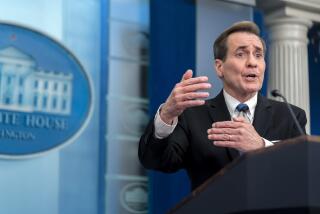Russia’s $200-Million Stunt--Call It Gambling on a Real Long Shot : Diplomacy: Satellite payload full of trinkets plunges into the Pacific--but it doesn’t make much of a splash.
- Share via
SEATTLE — After a roar, a whoosh, a ker-splash--and maybe the faint sound of a fizzle--one of the strangest global publicity stunts of the technological age came to its, ah, climax Tuesday on a Seattle wharf.
And with it came a question. Can’t we have any fun at the end of the Cold War?
The event, which might have been called From Russia With Love, has spanned several days and covered 2.8 million Earth miles at a cost estimated, and no doubt accurately so, at something between $3 million and $200 million.
What happened was this: At the urging of a Seattle business promoter, the Russians launched their Soyuz model intercontinental ballistic missile toward the United States earlier this month. During the weekend, its orbiting payload, a trinket-laden satellite, dropped into the Pacific off the coast of Washington. With a once-secret spy frigate, the Russians then fetched the globe-circling pinata and brought it here--all in the hope of generating business trade and cultural good will.
Ho-hum, said the Americans.
A crowd of barely 500 people, many of them schoolchildren and Russians, greeted the arrival of the 23,000-ton Marshal Krylov and its satellite cargo Tuesday on a crisp, cloudless day.
The ranking U.S. dignitary, Seattle Mayor Norm Rice, himself not one to coin a phrase, said the mission showed “we can beat our swords into plowshares. . . . This is an historic moment for time immemorial.”
The Russians were more numerous, more loquacious and higher ranking. Shoulder to shoulder in the ship’s Art Deco theater, military brass, political figures including a Russian governor and the new breed of Russian capitalists expressed friendship toward the United States and tried to put the mission’s goals into words.
A gesture of peace, they said. A demonstration of the commercial lift capability of the Russian space program. An overture to international trade--which also could be described as crass commercialism. The Russian way to mark “the 500th anniversary of Columbus’ discovery of America.”
What seemed to amaze the Russians most was the sight of U.S. journalists and camera crews climbing aboard the 600-foot Marshal Krylov, a vessel that fairly bristled with radar and other secret electronics.
So, what was inside the 2 1/2-ton capsule?
Well, until it cleared U.S. Customs and was carried through Seattle as part of the city’s Thanksgiving parade, that was supposed to be a secret. The hatches will stay closed until later in the week.
But word of some cargo did leak out, such as a goodwill message from Russian President Boris N. Yeltsin, a Christmas present for President-elect Bill Clinton, a cut-glass replica of the Statue of Liberty, assorted souvenirs, a stuffed dog from an artist who wanted to launch a new cartoon character and a pair of wedding rings, which a Russian couple was to put to use in Seattle this weekend.
Meanwhile, Russian and American business executives adjourned to a local hotel for a three-day trade conference.
American trade promoter Bob Walsh, who steered the 1990 athletic competition known as the Goodwill Games to Seattle, helped bring the space mission about. On a recent visit to the city of Samara on the Volga River he toured a Soyuz rocket factory where workers were idle.
“This mission symbolizes their need to convert their military factories from wartime to peacetime,” Walsh said. He added that the effort had attracted more publicity abroad than in the United States, which faces its own challenge for military conversion.
Walsh also said he shared one concern expressed by others about the mission. The very large cost estimates for the space effort, those in the range of $200 million, might be seen as spendthrift at a time when the Russians say they need billions of dollars in foreign aid.
More to Read
Sign up for Essential California
The most important California stories and recommendations in your inbox every morning.
You may occasionally receive promotional content from the Los Angeles Times.










